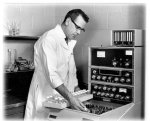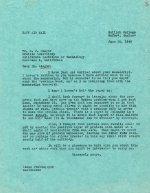|
In the summer of 1948, Itano began conducting electrophoresis experiments with help
from S. J. Singer. In 1947, Singer received his Ph.D. in chemistry from the Polytechnic
Institute of Brooklyn. Afterwards he was a postdoctoral fellow in Caltech's chemistry
department sponsored by the United States Public Health Service. When he arrived at
Caltech in 1947, Singer began working in immunology and therefore knew more than Itano
about the Tiselius machine and proteins. In fall 1947, Singer was enlisted to aid
Itano with the electrophoresis apparatus, and they eventually detected a difference
between sickle cell and normal adult hemoglobin. Singer left Caltech in 1951 for Yale
University where he taught for the next 10 years.
Ibert C. Wells earned his Ph.D. in biochemistry in 1948 from St. Louis University, the same institution
from which Itano received his MD. Wells and Itano had known one another at St. Louis
University as both worked with Dr. Doisy; and like Itano, Doisy suggested Wells to
Pauling. Wells was a National Research Council fellow at Caltech from 1948 to 1950.
Immediately after Caltech, Wells taught for ten years at the medical school of State
University of New York (SUNY) before moving to Omaha, Nebraska to chair the biochemistry
department at Creighton University's medical school.
Itano and Singer conducted the electrophoresis experiments that experimentally demonstrated
a difference between normal adult and sickle cell hemoglobin before Wells arrived
at Caltech. Wells performed other tests that were crucial to the publication; for
example, he isolated the porphyrins (in the heme) and determined that the difference
must be in the protein (or globin portion). Itano wrote his dissertation on the sickle
cell anemia work and in it he thanked Singer for helping with the electrophoresis
and thanked Wells (among others) for "discussions on other phases of the sickle cell
hemoglobin study."
|
|
Click images to enlarge

Ibert C. Wells, 1960s.

Letter from Linus Pauling to S. J. Singer. June 30, 1948.
"[M]y recommendation to young people, which I have been making for fifty years, is
that if you want to go into biology, biochemistry, molecular biology, why don’t you
start out by majoring in physics and chemistry and mathematics and then move on later?
I’ve even recommended...to students interested in biology to take the Ph.D. in chemistry,
rather than biology, and then...start work in...plant physiology or some other field.
With your basic understanding you will be able to be successful in this field."
|

